airship
 Most people know what a blimp is. It is an airship, but not the first airship. Most people have also heard of the Hindenburg…a airship than exploded causing an horrific crash. While one airship is loved by all who see it, and one met a horrible end, yet another airship brought fear to many. The third airship…a Zeppelin, which is a type of rigid airship named after the German Count Ferdinand von Zeppelin who pioneered rigid airship development at the beginning of the 20th century, was used at one time as a bomber.
Most people know what a blimp is. It is an airship, but not the first airship. Most people have also heard of the Hindenburg…a airship than exploded causing an horrific crash. While one airship is loved by all who see it, and one met a horrible end, yet another airship brought fear to many. The third airship…a Zeppelin, which is a type of rigid airship named after the German Count Ferdinand von Zeppelin who pioneered rigid airship development at the beginning of the 20th century, was used at one time as a bomber.
Zeppelin’s notions were first formulated in 1874 and developed in detail in 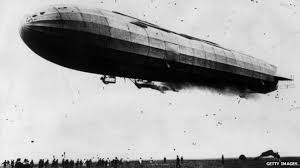 1893. When they were built, they were patented in Germany in 1895 and in the United States in 1899, as commercial passenger airships. The airship design was an outstanding success, and the word zeppelin is often used to refer to all rigid airships. Zeppelins were first flown commercially in 1910 by Deutsche Luftschiffahrts-AG (DELAG), the world’s first airline in revenue service. By mid-1914, DELAG had carried over 10,000 fare-paying passengers on over 1,500 flights. Those were the good years of its use.
1893. When they were built, they were patented in Germany in 1895 and in the United States in 1899, as commercial passenger airships. The airship design was an outstanding success, and the word zeppelin is often used to refer to all rigid airships. Zeppelins were first flown commercially in 1910 by Deutsche Luftschiffahrts-AG (DELAG), the world’s first airline in revenue service. By mid-1914, DELAG had carried over 10,000 fare-paying passengers on over 1,500 flights. Those were the good years of its use.
During World War I, the German military found a new use for the Zeppelins. They were used as bombers and scouts. The new Zeppelins brought terror to the people. During their use, the Zeppelins were used to kill over 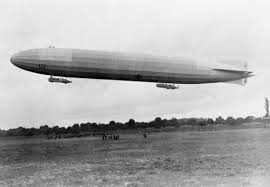 500 people in bombing raids in Britain. The new type of bomber didn’t, however, bring victory to Germany in World War I. When you think about it, how could an airship, like the Zeppelin make a good fighting aircraft. Its very design was far too vulnerable to any kind of bullet. I suppose that it was thought that there wouldn’t be many other “bombers” in the sky, but that doesn’t make the Zeppelin a safe bomber in any way. Nevertheless…safe, effective, accurate, or not…the Zeppelin worked as a bomber for a time. Unusual as it was, the slow-moving…about 84 miles per hour…airship had the distinct honor of being a bomber in World War I.
500 people in bombing raids in Britain. The new type of bomber didn’t, however, bring victory to Germany in World War I. When you think about it, how could an airship, like the Zeppelin make a good fighting aircraft. Its very design was far too vulnerable to any kind of bullet. I suppose that it was thought that there wouldn’t be many other “bombers” in the sky, but that doesn’t make the Zeppelin a safe bomber in any way. Nevertheless…safe, effective, accurate, or not…the Zeppelin worked as a bomber for a time. Unusual as it was, the slow-moving…about 84 miles per hour…airship had the distinct honor of being a bomber in World War I.
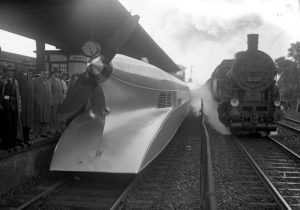 The Schienenzeppelin or rail zeppelin was an experimental railcar which resembled the Zeppelin airship. It was designed by the German aircraft engineer Franz Kruckenberg in 1929. The Schienenzeppelin was powered by a propeller located at the rear. The railcar accelerated to 143 mph setting the land speed record for a petroleum powered rail vehicle. Only one Schienenzeppelin was ever built due to safety concerns. It was never really put into service and was finally dismantled in 1939. The propeller, which powered the railcar, was also the source of concern for its safety. It was exposed, and so the concern was that someone might be hit by he propeller.
The Schienenzeppelin or rail zeppelin was an experimental railcar which resembled the Zeppelin airship. It was designed by the German aircraft engineer Franz Kruckenberg in 1929. The Schienenzeppelin was powered by a propeller located at the rear. The railcar accelerated to 143 mph setting the land speed record for a petroleum powered rail vehicle. Only one Schienenzeppelin was ever built due to safety concerns. It was never really put into service and was finally dismantled in 1939. The propeller, which powered the railcar, was also the source of concern for its safety. It was exposed, and so the concern was that someone might be hit by he propeller.
Anticipating the design of the Schienenzeppelin, the earlier Aerowagon, an experimental Russian high-speed railcar, was also equipped with an aircraft engine and a propeller. On 24 July 1921, a group of delegates to the First Congress of the Profintern, led by Fyodor Sergeyev, took the Aerowagon from Moscow to the Tula collieries to test it. Abakovsky was also on board. Although they successfully arrived in Tula on their maiden run, the return route to Moscow was not successful. The Aerowagon derailed at high speed near Serpukhov, killing six of the 22 people on board. A seventh man later died of his injuries.
The Schienenzeppelin railcar was built at the beginning of 1930 in the Hannover-Leinhausen works of the German Imperial Railway Company. The work was completed by Fall of that year. The vehicle was 84 feet 9 3/4 inches long and had just two axles, with a wheelbase of 64 feet 3 5/8  inches. The height was 9 feet 2 1/4 inches. It had two conjoined BMW IV 6-cylinder petroleum aircraft engines. The driveshaft was raised seven-degrees above the horizontal to give the vehicle some downwards thrust. The body of the Schienenzeppelin was streamlined, having some resemblance to the era’s popular Zeppelin airships, and it was built of aluminum in aircraft style to reduce weight. The railcar could carry up to 40 passengers. Its interior was designed in Bauhaus-style.
inches. The height was 9 feet 2 1/4 inches. It had two conjoined BMW IV 6-cylinder petroleum aircraft engines. The driveshaft was raised seven-degrees above the horizontal to give the vehicle some downwards thrust. The body of the Schienenzeppelin was streamlined, having some resemblance to the era’s popular Zeppelin airships, and it was built of aluminum in aircraft style to reduce weight. The railcar could carry up to 40 passengers. Its interior was designed in Bauhaus-style.
On May 10, 1931, the Schienenzeppelin exceeded a speed of 120 miles per hour for the first time. Afterwards, it toured Germany as an exhibit to the general public throughout Germany. There was still some concern due to the trains speed. On June 21, 1931, it set a new world railway speed record of 143 miles per hour on the Berlin–Hamburg line between Karstädt and Dergenthin, which was not surpassed by any other rail vehicle until 1954. The railcar still holds the land speed record for a petroleum powered rail vehicle. This high speed was attributable, in addition to other things, to its low weight, which was only 44800 pounds.
While several modifications were attempted, ultimately the Schienenzeppelin was scrapped. Due to many problems with the Schienenzeppelin prototype, the Deutsche Reichsbahn-Gesellschaft decided to go their own way in developing a high-speed railcar, leading to the Fliegender Hamburger (Flying Hamburger) in 1933. This new design was much more suitable for regular service and served also as the basis for later railcar developments. However, many of the Kruckenberg ideas were based on the experiments with Schienenzeppelin and high-speed rail travel, found their way into later DRG railcar designs.
The failure, if it could be called that, of Schienenzeppelin has been attributed to everything from the dangers of 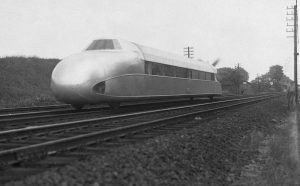 using an open propeller in crowded railway stations to fierce competition between Kruckenberg’s company and the Deutsche Reichsbahn’s separate efforts to build high-speed railcars. Another disadvantage of the rail zeppelin was the inability to pull additional wagons to form a train, because of its construction. Furthermore, the vehicle could not use its propeller to climb steep gradients, as the flow would separate when full power was applied. Thus an additional means of propulsion was needed for such circumstances. Safety concerns have been associated with running high-speed railcars on old track network, with the inadvisability of reversing the vehicle, and with operating a propeller close to passengers.
using an open propeller in crowded railway stations to fierce competition between Kruckenberg’s company and the Deutsche Reichsbahn’s separate efforts to build high-speed railcars. Another disadvantage of the rail zeppelin was the inability to pull additional wagons to form a train, because of its construction. Furthermore, the vehicle could not use its propeller to climb steep gradients, as the flow would separate when full power was applied. Thus an additional means of propulsion was needed for such circumstances. Safety concerns have been associated with running high-speed railcars on old track network, with the inadvisability of reversing the vehicle, and with operating a propeller close to passengers.
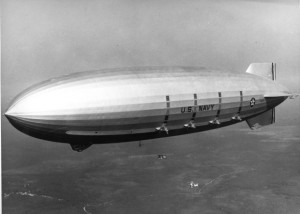
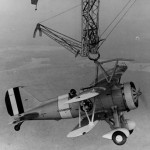 I think most of us have heard of the Hindenburg…the hydrogen filled blimp like airship the crashed in a ball of fire on May 6, 1937, bringing with it a loss of 36 lives…amazing when you consider that there were 97 people on board when that ball of fire crashed. What many people may not know is that the Hindenburg was not the only hydrogen powered airship. The USS Macon (ARS-5), named for Macon, Georgia and operated by the United States Navy for scouting and served as a “flying aircraft carrier” as well. It was designed to carry biplane parasite aircraft. Macon held single seat Curtiss F9C Sparrowhawks for scouting or two seat Fleet N2Y-1 for training. The Macon was a little under 20 feet shorter than the Hindenburg. The USS Macon also had a sister ship…the USS Akron (ARS-4).
I think most of us have heard of the Hindenburg…the hydrogen filled blimp like airship the crashed in a ball of fire on May 6, 1937, bringing with it a loss of 36 lives…amazing when you consider that there were 97 people on board when that ball of fire crashed. What many people may not know is that the Hindenburg was not the only hydrogen powered airship. The USS Macon (ARS-5), named for Macon, Georgia and operated by the United States Navy for scouting and served as a “flying aircraft carrier” as well. It was designed to carry biplane parasite aircraft. Macon held single seat Curtiss F9C Sparrowhawks for scouting or two seat Fleet N2Y-1 for training. The Macon was a little under 20 feet shorter than the Hindenburg. The USS Macon also had a sister ship…the USS Akron (ARS-4).
The USS Macon was in service less than two years, when on February 12, 1935 it was damaged in a storm and crashed off California’s Big Sur coast. Most of the crew was saved, and the wreckage remains on the ocean floor. The site of the wreckage remains on the United States National Register of Historic Places. I find myself interested in things like shipwrecks and plane crashes, but the ones underwater are especially interesting, because they are so inaccessible to most people. The USS Macon, like the Hindenburg proved not to be the best choice of an airship. There were really to many conditions that could easily bring them down. And the fact that they contained so much helium made then a flying bomb, in all reality. I don’t suppose that was something they considered when making these machines, but I’m sure it later became the reason that they discontinues this type of airship. I find it quite sad that it too two crashes to realize that they were not the safest way to fly.
I suppose they served their purpose though. I think it’s amazing that they could actually carry a plane on a hook and let it take off from the air. Launching and recovery from the airship in flight was done using a skyhook. The Sparrowhawk had a hook mounted above its top wing that attached to the cross-bar of a trapeze mounted on the carrier airship. For launching, the trapeze was lowered clear of the hull into the moving airship’s slipstream. With engine running, the Sparrowhawk would then disengage its hook and fall away from the airship. For recovery, the biplane would fly underneath the airship, until it was beneath the trapeze. The 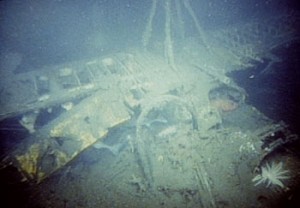
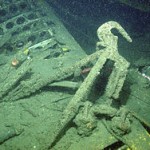 pilot would climb up from below, and hook onto the cross-bar. Once the Sparrowhawk was secure, it could be hoisted by the trapeze back within the airship’s hull, the engine was cut as it passed the hangar door. To me, this seems like a tricky maneuver, but the pilots soon learned the technique and said it was much easier than landing on a moving aircraft carrier. Soon, the pilots acquired the nickname “The men on the Flying Trapeze” and their aircraft were decorated with appropriate emblems. Now to me…that is cool!!
pilot would climb up from below, and hook onto the cross-bar. Once the Sparrowhawk was secure, it could be hoisted by the trapeze back within the airship’s hull, the engine was cut as it passed the hangar door. To me, this seems like a tricky maneuver, but the pilots soon learned the technique and said it was much easier than landing on a moving aircraft carrier. Soon, the pilots acquired the nickname “The men on the Flying Trapeze” and their aircraft were decorated with appropriate emblems. Now to me…that is cool!!

